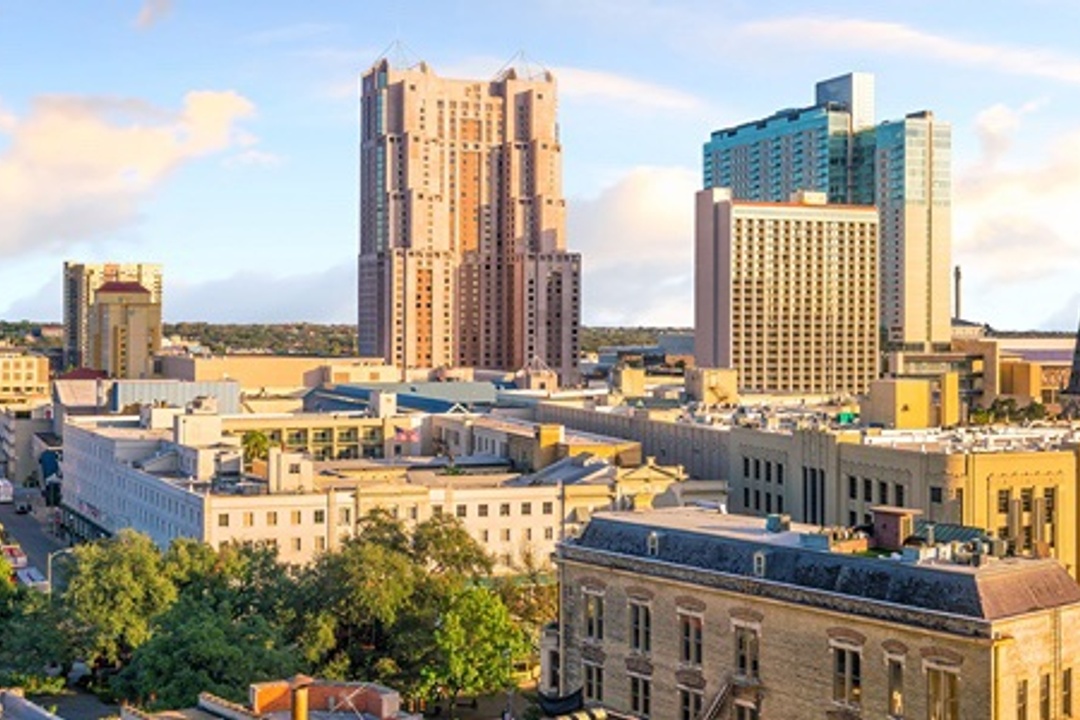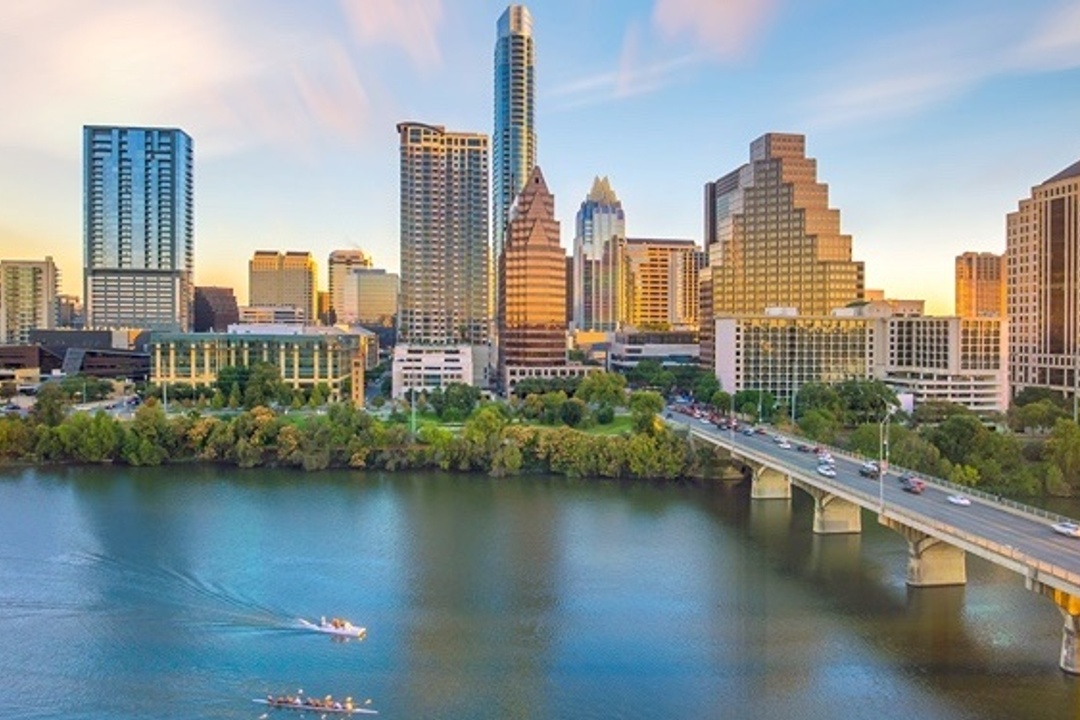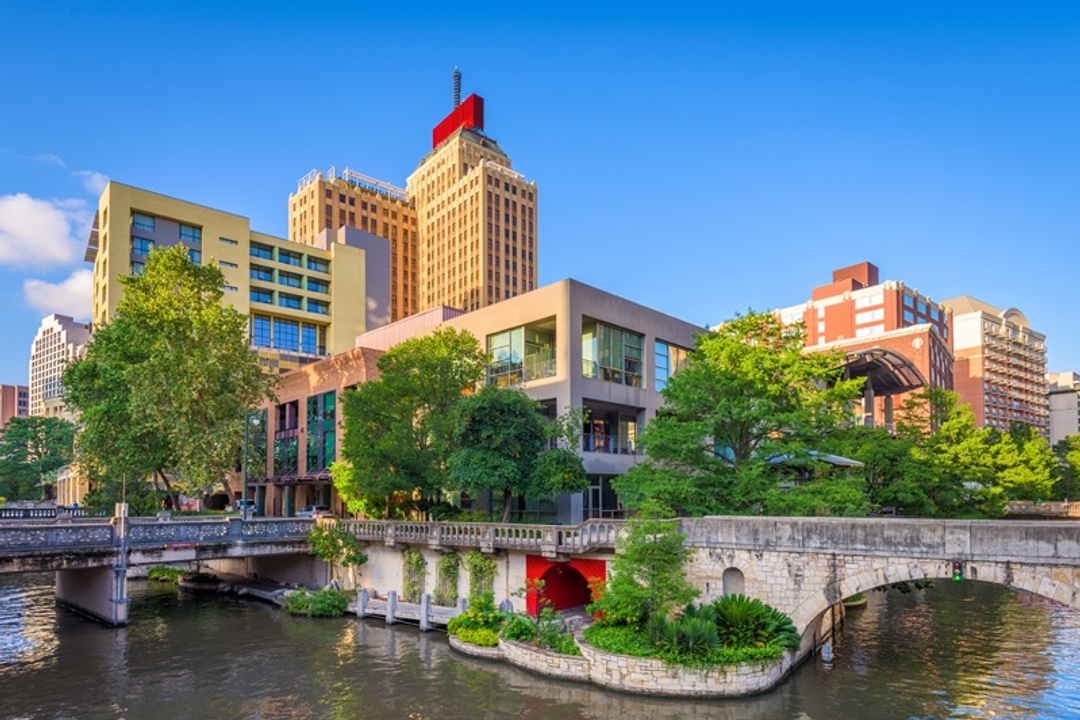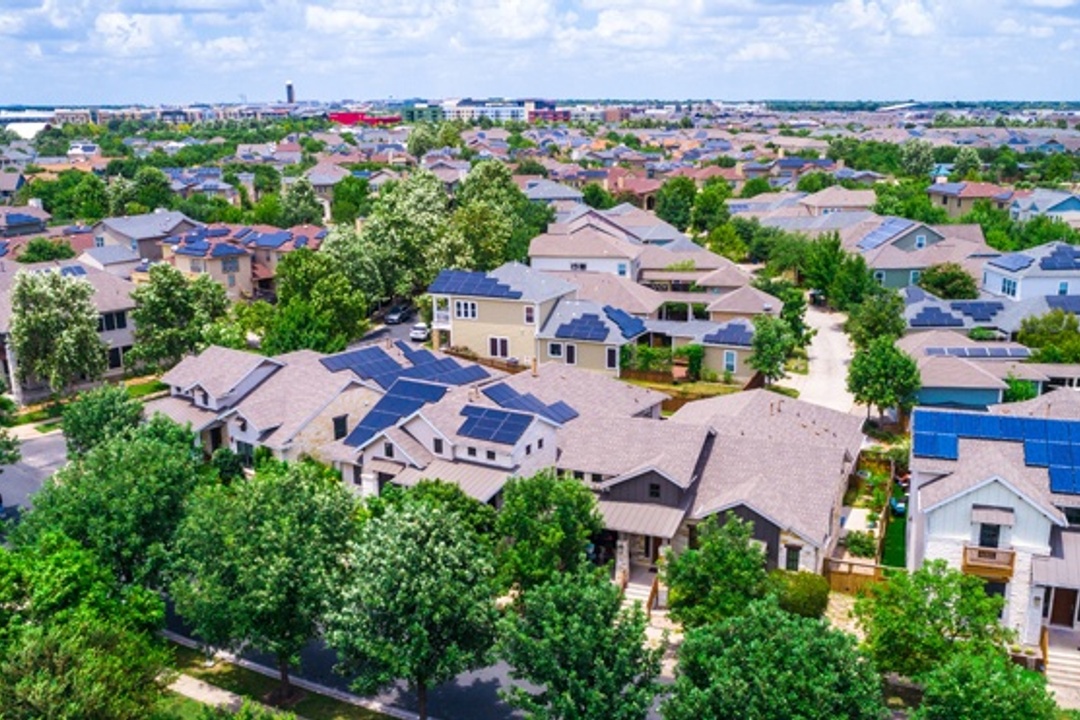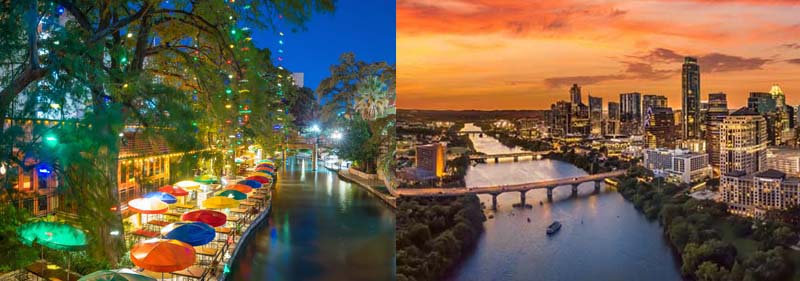
If you want to relocate to Texas, you can't go wrong with either San Antonio or Austin. Both locations are excellent choices for anyone wishing to relocate to Texas and possibly buy a home. However, there are significant variations between the cities that should be noted and might assist you in making an informed decision.
Despite their proximity, these two cities have distinct differences. Nonetheless, these cities both have natural beauty, entertaining activities, nightlife destinations, and booming economies to offer prospective home buyers and renters. Before moving to either of the cities it is important to examine the cost of living in each of the cities to pick which area best fits your lifestyle.
Luckily, this guide will break down everything you need to know about choosing between Austin and San Antonio as a place to live.
Job Market
The possibility of job growth and upward mobility is often a big factor in any move, so analyzing the economic situations in both Austin and San Antonio may help you decide which place is ideal for you in terms of career.
Austin's economy is seeing strong job growth and reduced unemployment. The current unemployment rate is around 3 percent, and future job growth is expected to be around 25.5 percent during the next 10 years. Austin has nonetheless managed to grow positively over the last three years, with a 1.7 percent gain in job growth.
In comparison, San Antonio remains one of Texas' fastest-growing cities. The San Antonio economy is doing well, with an unemployment rate of around 3.6 percent in September from 3.7 in August. The metro’s unemployment rate is higher than the U.S. rate of 3.5 percent but below the state rate of 4.0 percent. Meanwhile, the San Antonio labor force grew at a 4.0 percent annualized rate and predicted job growth of 15.2 percent over the next 10 years.
Winner: Both cities can anticipate booming economies and healthy job growth in the future, but Austin’s numbers put it atop nationwide lists of cities to watch, giving it a clear advantage.

Housing Costs
Austin and San Antonio have become two of the fastest-growing cities in the United States, with many new residents working in the booming tech industry. In fact, both cities' populations have been growing by about 145 people a day. With supply comes demand, as well as the rising cost of housing.
In terms of the overall housing costs, there is a significant difference between Austin and San Antonio. According to recent statistics, the median housing price in Austin hangs around $470,000, while in San Antonio it averages around $348,246.
In terms of renting, the price of rent will typically be lower in San Antonio compared to Austin. What you might get for $950-$2,500 in Austin, you might be able to find in San Antonio for closer to $850-$1,000. On average, the cost of rent in San Antonio is $1,529 for a three-bedroom home compared to $2,030 in the city of Austin. Of course, pricing is relevant based on what you’re looking for location and finishes-wise.
Winner: Austin is well-known for its low inventory of homes for sale, and its prices reflect that scarcity. Thanks to its much larger crop of options at far gentler prices, we consider San Antonio a more affordable destination for real estate buyers.
Houses for Sale in San Antonio

Cost of Living
When thinking about relocating to San Antonio or Austin, it is important that you factor in the local cost of living before making your final decision. Cost of living refers to the total sum of all of those necessary living expenses, like food, clothing, housing, and transportation.
According to Sperling's Best Places, Austin's cost of living is 33 percent greater than that of San Antonio. Austin has higher prices for food and groceries, utilities, transportation, and healthcare. Austin housing is more expensive, but it is also rapidly expanding to accommodate more inhabitants. Austin's median home price is $470,000. In comparison, the median house cost in San Antonio is roughly $348,246
In terms of utilities, the cost of utilities in Austin costs 4.4 percent more than in San Antonio. This difference means that utilities paid in Austin like gas, rentals, food, electricity, and other internet costs more than in San Antonio.
Winner: One of the first considerations you’ll likely have is the cost of living. San Antonio definitely wins out here for affordability.
Houses for Sale in San Antonio

Education
San Antonio is the "bigger" of the two cities in the corridor, with a population of over 1.5 million; Austin has a population of just under 1 million. As a result, it stands to reason that San Antonio has far more schools than Austin. According to GreatSchools, San Antonio has 1,095 schools (preschool through high school), but Austin has only 715 (preschool- high school).
However, Austin has an advantage in terms of overall school excellence, with six metro Austin schools obtaining 10/10 ratings on the site. Austin has a significantly higher percentage of top-rated schools than San Antonio, which has three 10/10 institutions.
Austin and San Antonio are both important locations for higher education in Texas; the Austin metro area has roughly a dozen colleges and institutions, while San Antonio has more than 30. Trinity University, St. Mary's University, and a satellite campus of the University of Texas are located in the San Antonio area. However, Austin has a stronger claim to the title of "college town" due to the presence of the University of Texas's flagship campus.
Winner: Both areas are home to great public schools as well as both public and private colleges. However, the presence of the highly rated Eanes School District in Austin gives it the win.

Healthcare
The cost of healthcare is an important consideration of the cost of living in any city. Fortunately, doctor visits and prescriptions in Austin and San Antonio are slightly lower than the national average.
A visit to an Austin area doctor typically costs residents an average of $123 per visit. This varies according to whether patients have any procedures done while at the doctor. A trip to the dentist, meanwhile, costs slightly less, at about $105.59. Residents that need new eyeglasses can expect to pay around $114.58 to visit the eye doctor. The prices that Austin residents pay at the pharmacy vary according to their age and insurance coverage, but the average cost for prescriptions is about $492.30 each year.
Overall, the cost of healthcare in San Antonio is 7 percent lower than the national average. If you schedule an appointment for your yearly physical, you will be charged an average of $110 for that visit depending on your insurance. A trip to the dentist will cost on average $94.07 before insurance, whilst residents of other cities will spend around $99.44.
In addition, prescription drugs will cost an average of $437.26 and a quick trip to a veterinary doctor will cost an average of $55.41 respectively. In San Antonio, the average annual health insurance premium is $2,585. Aetna Health Inc. and Scott & White Care Plans are two major healthcare insurance providers available to San Antonio citizens.
Winner: For this category, Austin wins when it comes to prioritizing health thanks to its multiple healthcare facilities.

Transportation
Austin and San Antonio are both car-dependent cities, with the majority of commuters relying on private vehicles. Austin and San Antonio both have significant traffic and congestion, but Austin has the worst record in terms of travel time.
According to TomTom research, Austin is the 19th most congested city in the United States, while San Antonio is ranked 54th. Both cities have public transportation systems; Austin's CapMetro offers buses as well as MetroRail trains that run between downtown Austin and areas such as Leander. The VIA and VIVA bus networks in San Antonio transport citizens across the city.
In Austin, rush hour begins as early as 6 a.m. and lasts until around 9 a.m. Interstate 35 is congested beginning at 6:30 a.m., but weekday traffic peaks at 8 a.m. The evening rush hour lasts from 4 to 7 p.m. Traffic begins as early as 3 p.m. and reaches its peak around 5 p.m.
San Antonio has a lot of traffic centered around downtown, which extends into more open areas around the suburbs. Although major freeways are available, traveling by main streets is also an option. In San Antonio, rush hour is from 7:30 a.m. to 9 a.m. and again from 4:30 p.m. to 6 p.m.
Winner: San Antonio and Austin have comparable public transit systems, and San Antonio suffers from slightly less traffic congestion than Austin. However, Austin’s bike-ability and walkability far exceed San Antonio's, giving it the win in this section.

Crime Rate
Investigating an area’s overall safety should be one of the first things you do before purchasing and committing to a new home. Thankfully, in today’s world, crime reports and city profile information have never been so easily accessible.
In 2021 Austin reported 4,981 violent crimes and had a crime rate of 511.66 per 100,000 residents. Austin’s crime rate is 28 percent higher than the national average and is on par with cities like Portland, New York, and Fort Worth.
In comparison, San Antonio had the 38th highest violent crime rate in the country in 2019, with 707.50 incidents per 100,000 residents. It also ranked 19th for Property Crime rate in the country, 4,844.84 per 100,000 residents. San Antonio’s violent crime rate is 50 percent higher than the national average and San Antonio’s property crime rate is more than double the national average
According to NeighborhoodScout, you have a 1 in 140 chance of being a victim of violent crime in San Antonio compared to Austin, where you have a 1 in 245 chance of being a victim of violent crime, which is far less. When making a decision on which city to move to in Texas, it is important that you check the city’s safety ratings and crime rates before deciding to move.
Winner: On average, you'll find that most data ranks Austin as being far safer than San Antonio thanks to its lower violent and property crime occurrence.

The Food Options
Even within the state of Texas, Austin's status as an iconic destination for regional food favorites like breakfast tacos and BBQ is unrivaled. East Austin and South Lamar draw locals and visitors alike for their exceptional restaurants, which range from super-casual food trucks to high-end boîtes.
Famous barbecue temple Franklin Barbecue cemented East Austin's reputation as a must-visit dining destination. While this well-known smokehouse isn't available for on-site eating, aficionados of Franklin's brisket can acquire it to go through the restaurant's curbside pickup program. Austin is also proving to be a vibrant site for post-pandemic-inspired pop-up eateries; from the juicy White Castle-inspired sliders at Golden Tiger to the high-brow spins on Taco Bell classics at Taco Fuego.
In recent years, restaurant owners are fast expanding into San Antonio's area due to the low cost of rent and other running costs. Hip bistros like Clementine and Southerleigh exist alongside heritage restaurants like La Fonda on Main and Schilo’s, making San Antonio’s dining scene a beautiful blend of old and new. San Antonio even has its own signature taco: the puffy taco.
Winner: Austin’s world-class food scene stands on its own, but San Antonio’s emerging trendy spots and classic food arenas make it a destination-worthy place for excellent dining.

Nightlife
Austin's nightlife is diverse, including everything from concerts to nightclubs, comedy, and bars. Stubb's Barbecue in downtown Austin is a local favorite for real barbecue and live music. Nightclubs abound, but The Concourse Project, an indoor-outdoor music and event center has since attracted Austinites and music lovers worldwide.
For a more relaxing night out, Cap City Comedy Club has major names and local stand-up comedians. Finally, there are just too many bars in Austin to choose just one. After 150 years in operation, one famous site, Sholz Garten, still serves traditional German cuisine with Texas favorites and a variety of beers.
San Antonio's nightlife is equally diversified. Blue Bonnet Palace organizes a variety of concerts on its indoor and outdoor stages, beginning with live music venues. The Howl at the Moon is a high-end nightclub with nice furnishings and unique martinis that will make you feel like a VIP. There is always a lot of music and dancing at the Pegasus NightClub.
Finally, San Antonio's bars provide world-class drink menus. Mad Dogs British Pub serves draft and imported beers, creative cocktails, and refreshments on a tropical terrace. The Menger Bar in San Antonio's 162-year-old Menger Hotel is maybe similarly historically noteworthy.
Winner: While both Austin and San Antonio are large cities with plenty of nightlife opportunities in both, Austin may have a slight edge on the competition due to the ease of accessibility.

Cultural Options
When it comes to culture, Austin outshines San Antonio. It's no surprise it's been dubbed the "Live Music Capital of the World." On a regular basis, bars, restaurants, and performance venues throughout the city welcome local musicians, with East Austin, South Congress, and Zilker areas having particularly high densities of live-music locations.
Austin also has a plethora of museums and galleries; be sure to check out the vibrant East Austin art culture, which rivals that of other big urban regions such as Brooklyn, New York, and Los Angeles. Additionally, museums such as the Blanton Museum of Art and The Contemporary Austin-Jones Center have remarkable permanent collections as well as traveling exhibits.
History lovers flock to San Antonio on a daily basis to see key historical landmarks such as the Alamo. Those who enjoy art exhibits can visit the San Antonio Museum of Art and the McNay Art Museum, a smaller venue focusing on modern and contemporary art. Although San Antonio's music industry lacks the cultural cachet of Austin's, local aficionados of live concerts are not short of options. Fitzgerald's Bar, Rebar, and 502 Bar all often host both local and visiting performers for energetic sets.
Winner: Both San Antonio and Austin are winners in this category when it comes to cultural options. There’s a lot to see and do, from museums to art galleries to points of historical interest.

Outdoor Activities
Outdoor recreation in Austin is extensive. Hikes, bike rides, and aquatic activities are available to Austin residents thanks to streams, green belts, state parks, and springs. Barton Creek Greenbelt, McKinney Falls State Park, and Pedernales Falls State Park are among the outdoor highlights, where the river flows past limestone cliffs and into the shadowed tranquility of a mesquite woodland.
San Antonio offers a diverse range of outdoor activities. Hiking and bike routes abound, but tubing down the Guadalupe, San Marcos, Comal, and Frio rivers is a San Antonio favorite.
With a playground and proximity to one of Texas' deepest lakes, as well as the area's wooded hills and many outdoor leisure activities, this place is a popular camping destination all year.
Winner: There are numerous outdoor activities and recreational centers in the city of Austin and San Antonio. In this category, Austin wins hands down due to the easily accessible outdoor parks littered across the city.

Sports
In the Austin area, a variety of Division 1 and 2 sports teams compete. Men's and women's rugby both win national championships and compete at multiple levels. Soccer, football, hockey, baseball, and roller derby are among popular sports. Perhaps most impressively, the University of Texas Longhorns have won 51 national championships.
Professional sports teams perform well in comparison to other national teams, but Austin's philanthropic organizations also gain notice. Texas Rollergirls is a non-profit public charity, and Central Texas Wolfpack is a philanthropic football club that raises funds for central Texas organizations.
Sports in San Antonio are not as diverse as in Austin, but they are nonetheless very popular among local inhabitants. Sports fans in the area can enjoy minor league baseball and soccer in addition to the San Antonio Spurs and women's San Antonio Stars basketball clubs.
Winner: While both cities offer spectator sports fans plenty to cheer for, Austin tops San Antonio for its many professional teams and well-developed university football and athletic teams.
The Bottom Line
There are numerous factors to consider while relocating to Austin or San Antonio. Residents of both places have nothing to worry about, as job availability is a major factor. A strong economy is the result of low unemployment and rapid growth.
Both places have major commutes and rush hours to contend with as booming cities, however, there are suburbs close to downtown that may reduce commuting time. Finally, these cities provide a wide range of recreational possibilities for outdoor enthusiasts as well as bar hoppers looking for distinctive drinks and sights. These two large Texas cities have a lot to offer anyone wishing to reside in a booming metropolitan area.
If you're looking to buy a home in Austin or San Antonio, contact BHGRE HomeCity to speak with a knowledgeable local real estate agent and find your dream home now.


